

Why a GFCI Keeps Tripping (Solved)
Hubert Miles | Licensed Home Inspector, CMI, CPI
Updated on February 17, 2024
There are several different reasons why a GFCI keeps tripping. The most common reason is water or moisture that has gotten into the receptacle box or outlet. However, a tripping GFCI device could also get caused by an overloaded circuit, a malfunctioning outlet, electrical issues, or improper installation.
According to the National Electric Code (NEC), you must install Ground Fault Circuit Interrupter (GFCI) outlets and breakers in specific locations throughout your home. GFCI protection offers an extra layer of protection to your home’s electrical system. Still, they can be highly inconvenient if they’re constantly tripping and killing power to your outlets.
When a GFCI keeps tripping, it’s inconvenient, but it often happens for a reason. You must get to the root of the cause behind your tripping outlet or breaker, especially if the electrical problems persist. It’s also essential to understand the purpose of GFCI devices and why electricians install them in the first place.
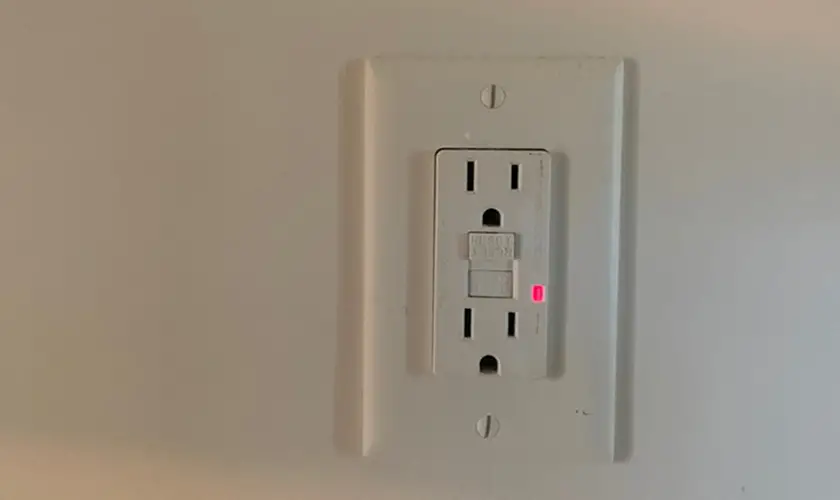
Get FREE estimates from licensed electricians in your area today. Whether you need to replace an outlet, hang a ceiling fan, a new electrical panel, or repair wiring, We Can Help!
What is the Purpose of GFCI?
Ground fault circuit interrupters protect you from a fatal electrical shock around your home. GFCI devices can detect small electrical leaks between hot wires and neutral wires.
A ground fault occurs when the incoming electrical current flow exits on the hot side of the outlet but doesn’t return the same electric current flow to the neutral side. If the current flows aren’t the same, the device will trip and terminate electricity like a breaker.
An electrical leakage current is when the electric current deviates from its intended path. The electric leak will attempt to take the shortest unintended path to the ground, creating an electric shock that can be fatal.
While there’s usually a good reason for a GFCI outlet to trip, it can also happen accidentally. Accidental trips are highly inconvenient and are often the result of improper wiring or installation or a faulty outlet. However, whenever a GFCI outlet is not working , you must get to the bottom of the problem, or it will keep happening.
What Causes GFCI to Trip?
Troubleshooting your GFCI devices is often a process of elimination. There are five main reasons why these outlets and breakers trip, and it’s challenging to put your finger on the right one without an in-depth investigation. To help you get started, let’s go over the five main reasons why GFI outlets trip and what to do about it.
There is Moisture Near the Outlet
The most common reason GFCI outlets trip is because of moisture or water in the outlet or outlet box. Water is hazardous around electricity, so GFCI outlets often get installed in potentially moist areas. These include bathrooms, kitchens, laundry rooms, outdoor areas, and unfinished basements or attics.
A physical splash of water is typically the cause of moisture in an outlet box and is easily detectable. However, in humid areas, such as Florida, it’s also possible for enough humidity to accumulate inside the outlet and cause it to trip.
The best way to prevent this is to install a new GFCI outlet and box with extra protection. Modern GFCI outlet boxes are waterproof and can withstand rain, humidity, and flooding. You should replace your old GFCI outlet with one to prevent further tripping.
Exterior outlets need GFCI protection and a bubble-type weatherproof cover to keep moisture at bay.
An Overloaded Circuit
Another common reason your GFCI will trip is an overloaded electrical circuit. An overloaded circuit happens when you are trying to operate too many appliances or electrical devices on the same circuit. Depending on the size of your electrical wiring, your GFCI circuit can only handle so much power.
An overloaded circuit can short circuit due to faulty or exposed electrical wiring. If two exposed wires are touching one another, it will cause the GFCI breaker or receptacle that’s powering them to trip. Unplug all the devices receiving power from the GFCI circuit breaker or outlet to determine if an overloaded circuit is a problem.
Next, plug everything back in, one device at a time, and see if the problem reoccurs. If it does, an overloaded circuit is likely the cause of your tripping GFCI.
Plugging appliances in one at a time is also an excellent way to determine which appliance is causing the problem. It may be necessary to wire it into a separate circuit or run a new circuit entirely.
A Ground-Fault Occurrence
Ground faults are when the hot wire touches the ground wire or something grounded. Ground faults get caused by several different things, including:
- Worn out insulation
The older your electrical wiring is, the more likely it is to have worn-out wiring insulation. When the insulation wears down enough, the hot wire can contact the ground wire and cause a ground fault.
- Corroded wires
The same is true for corroded or pinched wires.
- Dust or debris
If enough conductive dust collects in the outlet box, it can become an electrical conductor and leak electricity from the hot wire to the ground.
- Loose connections
When either a hot or neutral wire connections are loose, arcing (short circuit) occurs, which will trip the GFCI. The loose wire connection can be anywhere on the branch circuit between the circuit breaker and the GFCI receptacle outlet.
If you can’t visibly see the ground wire touching the hot wire, there’s still possibly enough electricity leakage to cause a tripped GFCI. You should contact a professional electrician or use an electricity leakage tester to see if this is the problem. If the insulation is worn enough, electricity can leak from the hot wire onto the ground.
- Defective appliances
A defective appliance can cause GFCI tripping to occur. A hairdryer can be a defective appliance. Defective electric motors inside common household appliances can cause current leakage, tripping a GFCI.
Nuisance Trips from a Refrigerator or Freezer
When a refrigerator trips a GFCI outlet, this usually means that it is drawing too much power from the circuit, usually when the compressor turns on. To prevent further trips, check if too many appliances are plugged into the same circuit and unplug any unnecessary items.
In older homes, it’s common for the kitchen lights and outlets to share one circuit. Since the refrigerator shares the circuit, the excessive draw can cause the refrigerator trips the GFCI breaker or outlet.
Be sure the outlet your refrigerator is plugged into has a 20-amp rating. If not, consider installing a dedicated 20-amp circuit for the refrigerator.
Many people like to put a spare refrigerator or freezer in their garage . These can often trip GFCIs that the NEC requires inside garages. If your new refrigerator keeps causing GFCI outlet trips, consider plugging it into a different outlet or installing a dedicated circuit.
Your Outlet Has Gone Bad
Like all electrical devices and components, outlets tend to go bad. On average, GFCI outlets last 15 to 20 years, but they can last longer or shorter depending on how your licensed electrician installed them. However, a faulty GFCI outlet will trip for no reason other than that it can’t handle electricity.
It’s good to test your electrical outlets once a month by pushing the TEST button on the outlet’s face. If it trips, the power outlet is working as it should. Press the RESET button once you have finished your test.
Improper Installation
Finally, it’s possible that you or an electrician didn’t install the GFCI outlet correctly. GFCI outlets have to get wired a certain way, and attaching the wrong wire to the wrong spot will cause your device to trip endlessly or not work.
How to fix a GFCI that Keeps Tripping?
When a GFCI outlet keeps tripping, it signals that a problem exists and needs your attention. The only way to permanently fix a GFCI that keeps tripping is to get to the root of the problem.
Nuisance tripping occurs when a GFCI trips for no apparent reason. Getting to the source of the problem of nuisance trips is the only way to ensure that tripping doesn’t reoccur, and you should take this seriously.
Your qualified electrician will likely need to replace the GFCI outlet or breaker and ensure no loose connections exist.
GFCI Keeps Tripping FAQs
When a GFCI keeps tripping, you probably have questions about how to troubleshoot why nuisance GFCI tripping occurs frequently.
Can moisture cause a GFCI to trip?
Moisture is one of the leading causes of a tripping GFCI outlet. Water can result from excess humidity, rain, or flooding.
Will a GFCI trip if it’s overloaded?
A circuit overload is when you try to power too many devices on the same circuit, and it will cause your GFCI to trip as a safety measure.
What causes a GFCI to trip repeatedly?
A GFCI may repeatedly trip if there is an electrical fault, such as a short circuit, or a ground fault, meaning the electricity exits the outlet via an unnatural path. It can also be caused by moisture exposure, worn-out wiring, overloaded circuits, or a bad GFCI sensor.
Final Thoughts
While tripping GFCI outlets is inconvenient, it’s a safety measure. In most cases, a tripping GFCI outlet is good and prevents you from getting electrocuted. These devices rarely trip for no reason, but they can happen. Whether you perform tests yourself or hire an electrician, you must get to why your GFCI is tripping in the first place.
Hubert Miles is a licensed home inspector (RBI# 2556) with more than two decades of experience in inspection and construction. Since 2008, he has been serving South Carolina through his company, Patriot Home Inspections LLC. As a Certified Master Inspector, Hubert is dedicated to providing his expertise in home inspections, repairs, maintenance, and DIY projects.
Continue Reading

Watts to Amps Calculator: DC/AC Wattage to Amps Conversion

70 Amp Wire Size: Breaker & Wiring Gauge Guide

80 Amp Wire Size: Breaker & Wiring Gauge Guide

200 Amp Wire Size: Service Length & Wiring Gauge Guide

10/2 or 10/3 Wire for Mini Split: A Professional Guide

GFI vs GFCI: Understanding the Key Differences

Founded by Hubert Miles, Certified Master Inspector
Home Inspectors
Calculators
Privacy Policy
Terms of Service
©2024 Home Inspection Insider 898 Whispering Pines Rd, Johnsonville, SC 29555 843-250-1882


How to Troubleshoot a GFCI Tripping Intermittently
- Updated January 28, 2024
Table of Contents
If your GFCI outlet is tripping intermittently, start by observing the tripping pattern and assessing the circuit load. Check for any visible issues like water or worn wires. If the problem persists, strategically test each appliance on the circuit, such as by moving them to different GFCI circuits to isolate the issue. In many cases, the culprit could be an aging appliance with a current leak, often requiring repair or replacement to resolve the GFCI tripping
Hi all, John here from Trustworthy Home Advice. I thought I’d share a recently intriguing issue in my home – a GFCI outlet in the garage that kept tripping intermittently, impacting several appliances in my basement. This journey of troubleshooting took me from the garage, where the GFCI outlet was located, down to the basement, where my extra freezer and refrigerator were connected. Let me share with you how I tackled this relatively challenging problem.
The Initial Problem:
The issue started with a GFCI outlet in my garage, which was part of a circuit extending to my basement. This circuit was important as it was powering my basement’s extra freezer, overflow refrigerator, and it is also connected to our garage door openers. The intermittent nature of the tripping, resetting and working fine for a few days, added complexity to diagnosing the issue. Because the freezer and refrigerator were full, I couldn’t just unplug one item at a time as you would normally do if a circuit breaker was tripped due to a short. There also was no obvious issue with water, worn wires or anything visible for that matter.
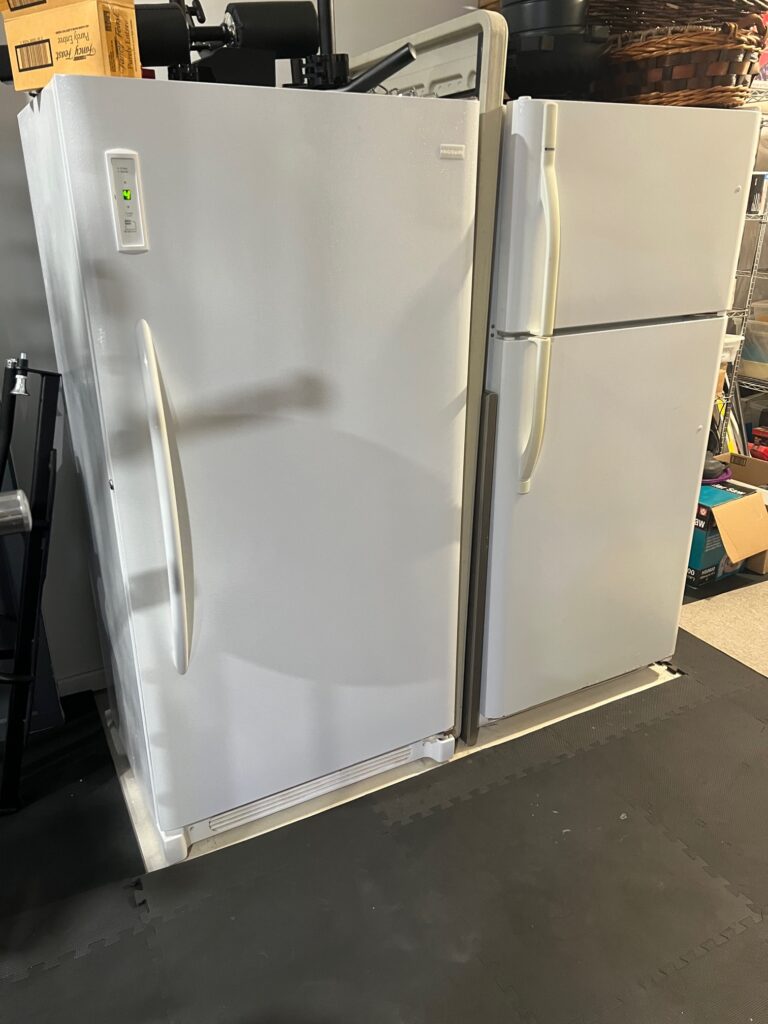
First Steps in Troubleshooting:
Although our home is only 5 years old and GFCI’s normally have a life span much longer than that, they can go bad . Believing the garage GFCI outlet itself could be the issue, I replaced it. However, the tripping continued, indicating that the problem lay elsewhere in the circuit.
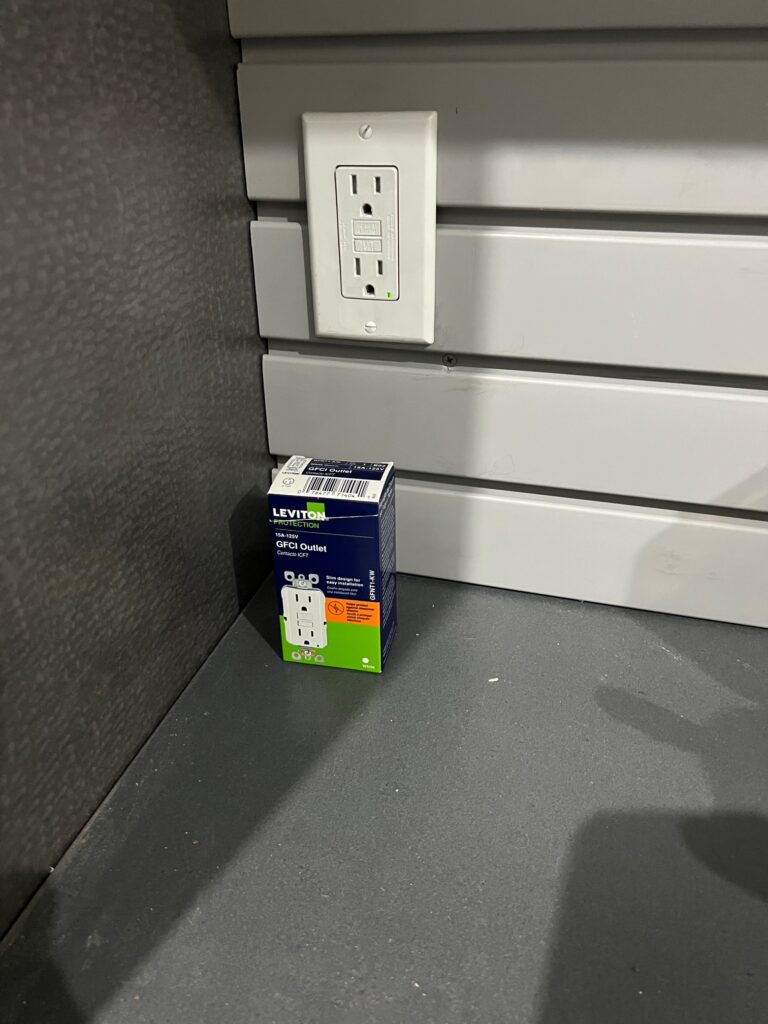
Deepening the Troubleshooting Process:
- Observing the Tripping Pattern: The irregular but consistent tripping suggested a persistent underlying issue. Even though the circuit reset and everything on the circuit, including the freezer and refrigerator seemed to be operating normally, something was tripping the GFCI.
- Assessing the Circuit Load: The circuit was powering multiple devices and appliances across different locations in the house, although the freezer and refrigerator were the most important. There was no moisture or water present, and there were no visible signs of wear on the appliances. From the picture above of the refrigerator and freezer, although they are both 15+ years old, they are visually in great shape.
- Strategic Testing: With both the freezer and refrigerator needing continuous power, I couldn’t simply unplug one for a long period, and I also didn’t want to plug one into a non-GFCI circuit for safety reasons. After unplugging everything else on the circuit and ruling out other potential sources, I concluded it had to be either the freezer or refrigerator. So, with an extension cord, I moved the refrigerator to another GFCI circuit in the basement (luckily I had a 2nd GFCI circuit nearby), leaving the freezer on the original circuit.
- After about a day, the circuit still tripped, but the 2nd circuit I moved the refrigerator to did not. So at this point, it sure seemed like the freezer was the problem
Definitively Identifying the Culprit:
I then switched the freezer and refrigerator circuits, now putting the freezer on the 2nd circuit and moving the refrigerator back to the original circuit. The moment of revelation came when, about 36 hours after relocating the freezer to the 2nd GFCI circuit, that circuit tripped, while the original circuit in the garage stopped tripping. I left this configuration in place for a few days and the patten continued, this definitively pointed to the freezer as the source of the problem.
Further Examination of the Freezer:
- Age of the Freezer: The freezer was over 15 years old, which made me consider the condition of its internal components.
- Potential Technical Issues: The possible issues could include insulation breakdown, moisture ingress, or failing electrical components like the compressor or thermostat.
The problem is most likely a current leak somewhere in withing the freezer system. When a freezer develops a current leak, it typically indicates a breakdown in its electrical insulation or a problem in one of its components, such as the compressor or thermostat. Over time, wear and tear or moisture intrusion can cause minor pathways for electricity to escape, not through the usual circuit, but instead leaking towards the ground. This leakage, even if minimal, can be enough to disrupt the delicate balance monitored by a GFCI outlet. The GFCI detects these irregularities in the flow of current, recognizing them as potential electrical shock hazards, and responds by tripping to prevent any further risk. In older freezers, such as in my case, this leakage is often a sign of aging and deteriorating internal components, necessitating repair or replacement to ensure continued safety and efficiency.
Decision to Replace the Freezer:
Given the freezer’s age and the associated electrical safety risks, I decided to replace it. This not only resolved the GFCI tripping issue but also improved the safety and efficiency of my home’s electrical system, not to mention the safety of the frozen food we have stored downstairs.
I decided to go with the Media 17 cu ft freezer .from Lowes for $699. Delivery was $29 and haul away for the old freezer was $50. (This is not an affiliate link, just showing you what I opter for) It’s also Energy Star Rated .

Reflecting on GFCI Outlet Importance:
This experience highlighted the critical role of GFCI outlets in home safety, particularly in circuits that span different areas of a home, like from my garage to the basement. For more insights into GFCI outlets, especially in older homes, I recommend reading our article on GFCI Outlet Requirements in Older Homes .
Addressing intermittent GFCI tripping can be a complex task, but with a systematic approach, it’s possible to identify and fix the issue. In my case, it was an aging freezer in the basement – a reminder of the importance of regular appliance checks and maintenance.
Final Thoughts:
When dealing with electrical issues, safety should always be your top priority. If you’re unsure, don’t hesitate to seek professional help. Keep following TrustworthyHomeAdvice.com for more home improvement stories and Essential Homeowner tips .
Would love to hear about any challenging troubleshooting issues you may have had to deal with, so please share below. Or, if you have any questions, feel free to leave a question in comment section or email me direcely.
Happy New Year!
At Trustworthyhomedvice.com we are interested in your comments and questions and will respond to ALL of them.
All comments are reviewed before they are posted.
Sign up for Fresh Content by entering your email address below. We try to publish several times per week with interesting/informative articles for Homeowners!
This Post Has 2 Comments
John, Thank you for the great information. Honestly just went through a similar situation and it took my husband and I a while to figure out what the problem was in the end. I think if we had had your information prior we would have drawn the conclusion that it was our chest freezer much sooner. Always enjoy reading your helpful and information topics. Happy new year to you and all! Kathie
Thanks Kathie, glad the info is helpful – hope all is well. FYI, we’re still working on Alyssa’s reno, and we will be posting, but we have a ton of video to edit – but we’re getting close. Hope you will take a look when we’re done!
Leave a Reply Cancel reply
Save my name, email, and website in this browser for the next time I comment.
Sign up to our newsletter!
- (317) 834-1922

Troubleshooting Guide: What to Do When Your GFCI Keeps Tripping
Ground Fault Circuit Interrupters (GFCIs) are crucial electrical safety devices that protect us from electrical shocks and potential hazards. However, it can be frustrating when a GFCI repeatedly trips, disrupting power to multiple outlets. Let’s explore the common causes behind GFCI tripping and provide a step-by-step troubleshooting guide to help you resolve the issue.
Role of a GFCI
To effectively troubleshoot a GFCI tripping issue, it’s essential to understand how it works. A GFCI monitors the electrical current flowing through a circuit. If it detects even a slight imbalance, such as current leakage due to a ground fault, it automatically shuts off the power to prevent electric shock.
Identify Potential Causes
There are several potential causes for GFCI tripping that you should be aware of. Here are a few of the most common causes you may encounter:
Ground Faults
The most common cause of GFCI tripping is a ground fault. This occurs when a hot wire encounters a ground wire or conductive material, creating a short circuit and causing the GFCI to trip.
Overloaded Circuits
GFCIs are designed to handle a specific amount of current. Overloading the circuit by plugging in multiple high-power devices simultaneously can cause the GFCI to trip.
Faulty Appliances or Wiring
If a specific appliance or wiring in the circuit has a fault, it can trigger the GFCI to trip. Identifying the faulty device is crucial to resolving the issue.
Resetting the GFCI
When the GFCI trips, the first step is to reset it. Locate the GFCI outlet or breaker and press the reset button. If it clicks and stays in place, the issue may have been a temporary fault. However, if it immediately trips again, proceed with the following steps:
1) Isolate the Problem
Unplug all devices from the GFCI-protected outlets.
2) Reset the GFCI
Gradually plug in one device at a time and reset the GFCI after each plug-in. If the GFCI trips after plugging in a specific device, that device may be faulty and needs further inspection or repair.
3) Check for Ground Faults
Inspect outlets, switches, and connections for damage, security, exposed wires in the circuit, and moisture in areas like bathrooms or outdoor outlets to prevent ground faults.
4) Address Overloaded Circuits
Identify outlets connected to the GFCI circuit and consider redistributing the load by connecting certain devices to non-GFCI outlets.
5) Seek Professional Help
If the issue persists or you are uncomfortable dealing with electrical troubleshooting, it’s best to contact a qualified electrician. They have the expertise to identify and resolve complex electrical problems safely.
Ready to Get Rid of GFCI Tripping?
GFCI tripping can be a nuisance, but understanding the causes and following a systematic troubleshooting approach can help you resolve the issue. By isolating the problem, checking for ground faults, addressing overloaded circuits , and seeking professional assistance when needed, you can ensure the safety and functionality of your electrical system.
Electrical work can be dangerous, so it’s crucial to prioritize your safety and consult a professional if you’re unsure about any aspect of the troubleshooting process. If you’re concerned about your GFCI tripping, contact Grounded Solutions to inspect it. We’re here to help you with any and all maintenance, installation, or general electrical needs!

- 450 E Mahalasville Dr Martinsville, IN 46151
Need excavation, drainage or concrete work?

- Privacy Policy
- Terms of Use
Stay enlightened with our newsletter!
Plug in and stay up to date on the latest insight, news and updates from Grounded Solutions.
Common Causes of GFCI Outlets Keeps Tripping and How to Troubleshoot Them

Why Do My GFCI Outlets Keep Tripping?
Common causes of gfci outlets tripping, outlet keeps tripping after reset, outlet keeps tripping with nothing plugged in, outlet keeps tripping when i plug something in, outlet keeps tripping without load, how to troubleshoot gfci outlet tripping.
- Check for Ground Faults: Inspect the vicinity of the outlet for indications of moisture, like water leaks or dampness. Ground faults, which can cause GFCI tripping, can occur due to moisture. It's crucial to promptly address any water-related problems to prevent potential ground faults and ensure the safety of the electrical system.
- Inspect Wiring Connections: To prevent GFCI tripping, it is important to inspect the wiring connections within the outlet box. Check for any loose or damaged wires, as they can cause a GFCI to trip. Safely turn off the power to the outlet and carefully examine the connections, tightening any loose screws or terminals for proper installation and secure connections.
- Test GFCI Outlet Functionality: To ensure the functionality of a GFCI outlet, press the "Test" button to simulate a ground fault and check if it trips correctly. Afterward, press the "Reset" button to restore power. If the GFCI fails to trip during testing or doesn't reset properly, it indicates a potential fault, and the outlet should be replaced to maintain electrical safety.
- Identify Overloading Issues: It's important to be mindful of the current rating of GFCI outlets, usually 15 or 20 amps. If multiple appliances or devices connected to the outlet exceed this rating, it can cause tripping. Evaluate the number of devices connected simultaneously and redistribute the load accordingly to prevent overloading and subsequent GFCI trips.
- Examine Water Exposure: In areas prone to moisture, such as kitchens or bathrooms, it is crucial to protect GFCI outlets with waterproof covers. Water exposure from splashes or high humidity can lead to GFCI tripping. By installing appropriate waterproof covers, you can safeguard the outlet from moisture-related issues and ensure its proper functionality.
- Consult a Professional Electrician: If the above steps do not resolve the problem or if you are uncertain about handling electrical troubleshooting, it is wise to consult a professional electrician. They possess the expertise to conduct a comprehensive assessment of your electrical system and provide appropriate advice or repairs, ensuring safety and reliable operation.
Home Alliance: Your Go-To Electrical Repair Work

Front-load washers are very effective and provide superior cleaning results. There is a drawback to this energy-efficient washer design; some customers have rep...

Electrical outlets give us the advantage of powering our homes and businesses with a simple plug-in. It is essential to provide convenience for various devices ...
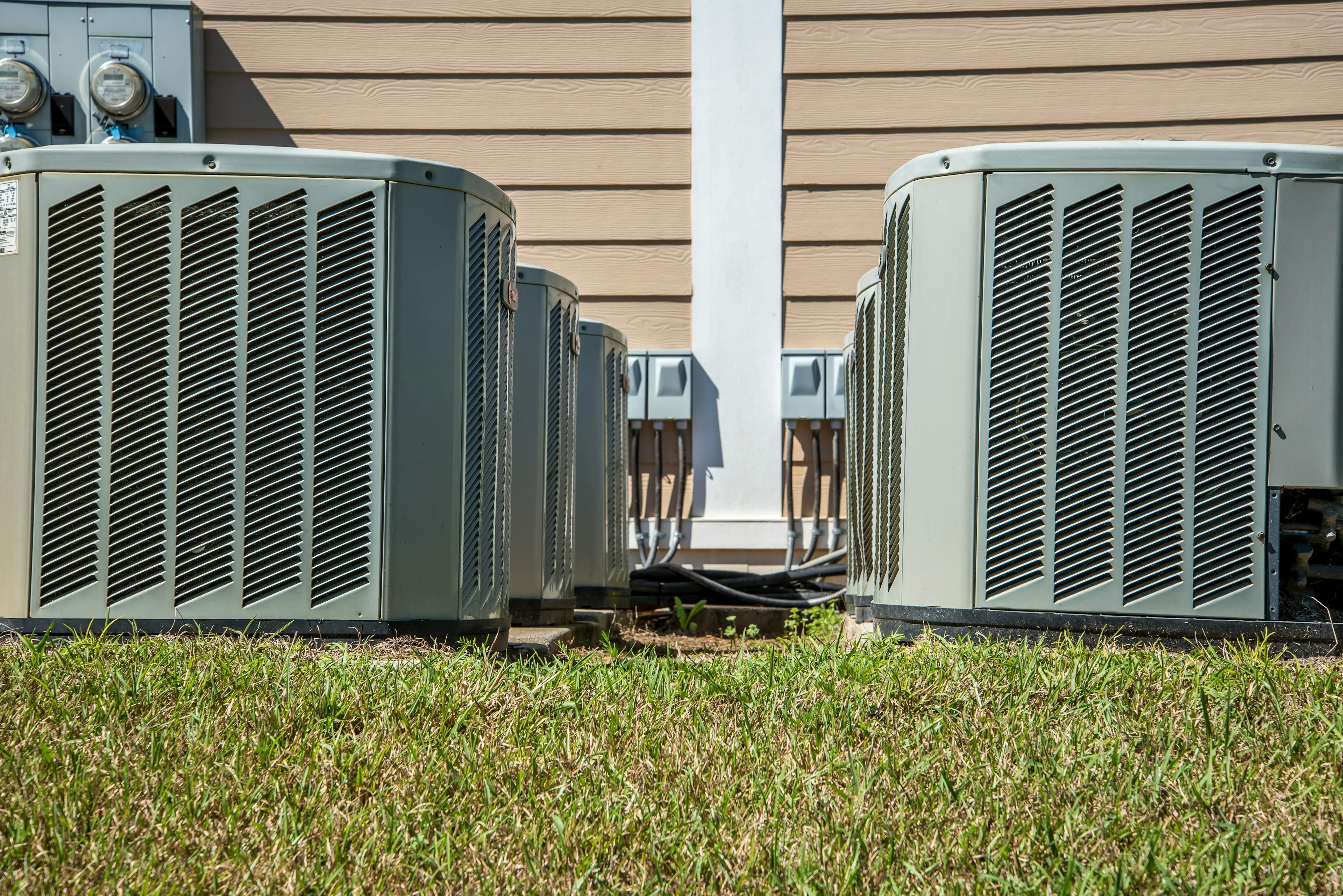
Heating, ventilation, and air conditioning systems are integral to maintaining comfortable living conditions and ensuring the quality of the air we breathe. The...
We Offer 100% Financing | Learn More

- 24/7 Emergency Electrical Services
- EV Charging Station Installation
- Appliance Wiring
- Ceiling Fan Installation & Repair
- Surge Protection
- Electrical Panels
- Outlet & Switch Installation
- Lighting Installation
- Smart Home Automation
- Electrical Service Upgrade
- 24/7 Emergency Plumber
- Bathroom Plumbing
- Kitchen Plumbing
- Water Heaters
- Water Treatment & Filtration
- Lift Station & Pump Services
- Drain Clearing
- Pipe Inspections
- Sewer Line Replacement
- Leak Detection
- AC Installation
- AC Maintenance Plans
- Ductless Mini-Split HVAC
- Indoor Air Quality Services
- Duct Services
- Thermostat Installation
- Special Offers
- About David Gray
- David Gray Comfort Club
- Service Areas
- In the News
- Pay Bill Online
- Call (904) 385-5920

back to blog
5 Reasons Your Ground-Fault Circuit Interrupter Outlets Keeps Tripping
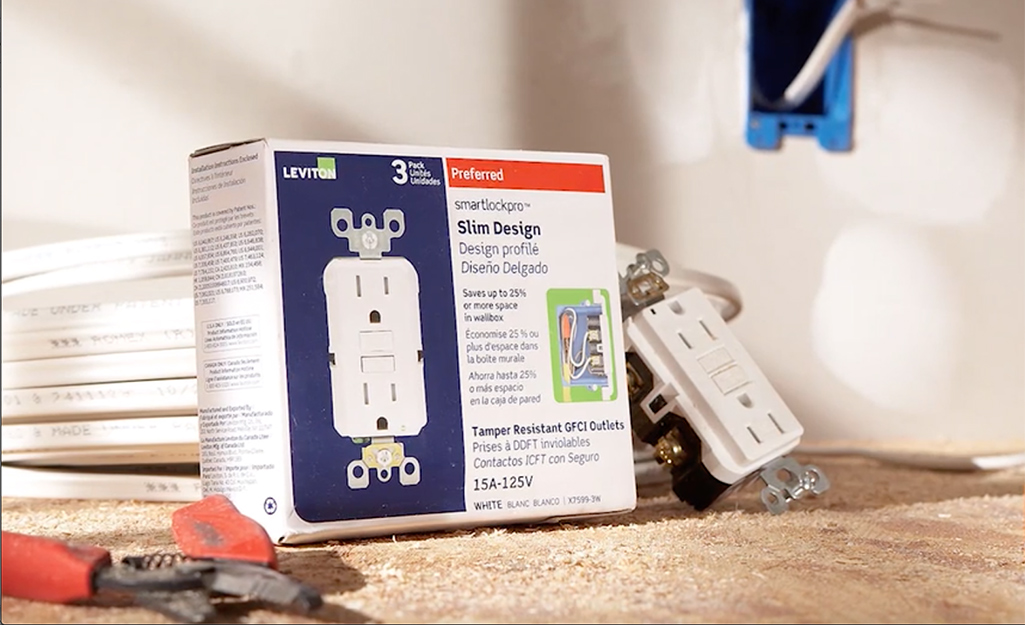
Ground-fault circuit interrupters are designed for your safety. Circuit interrupters, or "trips" as they are commonly referred to, are intended to reduce the risk of fire or electrocution. If they trip, it's an indication there is a problem and you'll need an electrician you can trust.
What Causes Ground-Fault Circuit Interrupter To Trip?
The top five reasons your GFCI outlet keeps tripping are ground-fault occurrences, moisture in the receptacle box, an overloaded circuit, an electrical fault, and a faulty GFCI outlet. We'll cover each of these issues, including causes and solutions.
1. Ground-Fault Occurrence
Ground faults occur when the hot wire or live wire comes into contact with the ground wire or the grounded area of an appliance. Usually, GFCIs function by detecting when the current is flowing along an unintended path (e.g., through water or a person).
The instant the GFCI detects there is even the slightest of current leakage as low as 0.005 amps, it trips right away.
How do you determine if the current is leaking? Unplug everything on that circuit and make sure all the switches are off. Check for any wear that may have occurred to the equipment. Any slight damage means the electrical part is no longer protected from contact.
2. Moisture in the Receptacle Box
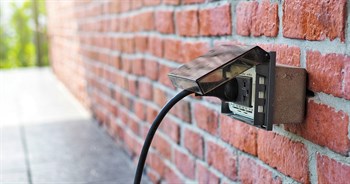
The accumulation of moisture is another major cause of GFCI tripping. Outdoor GFCI outlets are the most vulnerable, and rain is the most common culprit. However, due to the tropical climate of Florida, high humidity can also cause moisture buildup and make it harder for any water trapped in a receptacle box to evaporate.
Start your search by inspecting the receptacle box. Be sure to turn off the breaker before opening the box containing the receptacle. The box must be dry before you attempt to reset the GFCI. It is possible to speed up this drying process using a simple tool such as a blow dryer, but that part is best left to a professional.
If the installation is outdoors or located in high humidity areas, such as the bathroom or kitchen, make sure the box is weatherproof and locked even when the receptor is in use. The presence of moisture can expose you to the risk of accidental electric shock.
3. Overloaded Circuit
Circuit overload occurs when more amperage flows through an electric wire or circuit than it can handle. This may happen if you connect malfunctioning or defective appliances. Loose, corroded wires or connections may also be to blame. Once the GFCI outlet senses an overload, it trips or "breaks" the circuit.
If you want to determine if overloading is really the problem, follow these steps in order.
- Unplug all the appliances connected to the circuit in question
- Reset the circuit on your fuse box
- Wait several minutes
- Plug an appliance back in and turn it on
- Check to see that your circuit has not tripped
- Plug in the next appliance, turn it on, check the breaker, and so on
You may find you'll need to replace the items causing the problem.
If the problem keeps reoccurring, you may need a new dedicated circuit and outlet that can handle the amperage required by the appliances.
4. Electrical Fault
If your GFCI outlet trips consistently, it could be an electric fault resulting from faulty structural wiring. An electrical outlet connected to the same circuit could also be the source of the problem, especially if it was not part of the original wiring of your home. In the case of an electrical fault, you will need a professional electrician to fix the problem.
5. Faulty GFCI Outlet
If you've tried all else and the GFCI outlet reset doesn't solve the problem, that means the outlet itself is defective. GFCI outlets have highly responsive internal circuitry to detect whenever there's a flaw in the electric system. With time, the sensitive circuitry wears out, rendering the outlet dysfunctional. In this case, the outlet will need repairing or even replacing and should be done by a qualified electrician.
Find an Electrician You Trust
David Gray Electrical Services offers a range of commercial and electric services. We have highly trained, licensed, and equipped technicians. If you're experiencing GFCI outlet tripping issues in the Jacksonville area, contact us to schedule an appointment .
Schedule Service
- * Select Service Air Conditioning & Heating Plumbing Electrical Other
- What can we help you with?
- SCHEDULE SERVICE
Serving Florida’s First Coast!
Electrical service: areas we serve.
- Atlantic Beach
- Jacksonville Beach
- Orange Park
- Neptune Beach
- St. Augustine Beach
- The Beaches
Plumbing Service: Areas We Serve
- Beverly Beach
- Flagler Beach
- Painters Hill

HVAC Service: Areas We Serve
Our current specials, free warranty, free surge protector, free air handler.

- Office Locations
6491 Powers Avenue, Jacksonville, FL 32217
15 Hargrove Lane, Unit 6K, Palm Coast, FL 32137
- © 2024 David Gray
- Privacy Policy
The information on this website is for informational purposes only; it is deemed accurate but not guaranteed. It does not constitute professional advice. All information is subject to change at any time without notice. Contact us for complete details.
Request Service
" * " indicates required fields
Your Promotional Selection Has Been Applied!

Understanding GFCI Nuisances
January 24, 2019
Since the expansion of the 2017 National Electrical Code (NEC) ground fault circuit interrupter (GFCI) requirements to include single-phase receptacles up to 50A and three-phase receptacles up to 100A, we’ve seen a trend of increased GFCI nuisance tripping. While these trips can be frustrating, it’s important to not create a code violation or put personnel at risk by removing GFCI protection. Often, a tripping GFCI device may be operating properly; it’s possible there is an equipment or wiring issue that needs to be addressed.
At Henderson Engineers, we’ve compiled the following information to help our clients understand why they may be experiencing an issue and suggestions on how to address it.
What is GFCI protection?
GFCI devices have been credited with saving numerous lives since their introduction to the NEC in 1971. This protection can be achieved via a GFCI circuit breaker or a GFCI receptacle. These devices reduce electrocution risks by measuring the electrical current between the phase conductor and the neutral return. If the return current differs by more than 4 to 6 mA, a dangerous amount of current is flowing somewhere it shouldn’t be – so the device shuts off. Per the 2017 NEC, GFCI protection is required in bathrooms, kitchens, rooftops, outdoors, within 6’ of a sink, and select other areas.
The NEC commentary explains that they expanded GFCI requirements to include higher voltages and current ratings because equipment connected to those receptacles present the same shock hazards as those of lower voltages and current ratings. Unfortunately, this expansion of the GFCI requirements has led to more nuisance tripping and owner’s asking, “Why is my GFCI not working?”
Common Causes of GFCI Trips
1. There are too many appliances being protected by the GFCI.
Sometimes tripping occurs when a GFCI circuit breaker is protecting multiple downstream receptacles. If several appliances are connected to the GFCI device, the cumulative effect of the appliance leakage currents may trip the GFCI. To ensure proper operation, minimize the number of appliances protected by the GFCI. Depending on the circuit length from the GFCI sensing device, it may be necessary to limit the number of appliances being protected to one or two.
2. The circuit is too long for the equipment being protected by the GFCI.
This is common in GFCI circuit breakers with circuit lengths over 150’. Capacitive leakages due to the wire length of the circuitry may exceed the threshold of the GFCI. (The actual length limitations vary depending on wire type and size.) To prevent this issue, place the GFCI device close to the equipment it will be protecting – this may mean using a GFCI receptacle or blank face GFCI device near a normal receptacle.
3. The GFCI was improperly wired by an electrician.
Have the installation checked to see if the GFCI receptacle and related circuitry are installed correctly. Verify the neutral is dedicated and connected to the correct circuit, etc. While testing of GFCI devices is not generally included in the basic scope of commissioning services, having a trusted third-party electrician or commissioning agent provide independent verification of proper installation may be necessary.
4. The area is too wet.
If nuisance tripping is occurring in areas near dishwashing, mop sink, janitorial, ice machines, showers, walk-in coolers, exterior locations, roofs, and other areas with a lot of condensation, then too much moisture may be the cause. Check to see if there are any environmental or operational changes that can be made to reduce moisture near the appliance and receptacle. Installing a weatherproof cover plate at the receptacle may be helpful.
5. An appliance may have manufacturing defects.
It’s possible an appliance may be leaking too much current to ground. Appliances are allowed a certain amount of leakage current per their UL listings; acceptable maximums may be as high as .75mA per appliance. Unfortunately, some equipment may not be built to the same standards as the prototype that passed testing. Now that more receptacles are required to have GFCI protection, equipment issues may be coming to light. If you have faulty equipment, contact the equipment supplier/manufacturer for repair or replacement.
6. The GFCI device may be defective.
These devices don’t last forever, and some are defective even when new. UL 943 covers Class A GFCI devices. GFCI breakers and receptacles should be replaced in accordance with manufacturer’s recommendations. Best practice is to test GFCIs monthly and replace them every 5 years.
Best Practices
GFCI devices trip for several reasons. The following best practices can help confirm proper operation and reduce nuisance tripping.
- Minimize the number of appliances protected by each GFCI.
- Minimize the circuit length from the GFCI circuit breaker to the receptacle – a maximum conductor length of 150’ is good rule of thumb.
- Verify GFCIs are installed per manufacturer’s recommendations and as required per code.
- Avoid excessive moisture around appliances and receptacle.
- Replace defective appliances.
- Replace defective or GFCI devices that are more than 5 years old.
- Maintain easy access to GFCI devices in case they need to be reset. (The 2017 NEC requires GFCI receptacles to be “Readily Accessible.” That means one must be able to reach the device quickly, without having to use ladders or climbing over obstacles, like large stationary kitchen equipment. GFCI breakers or blank face GFCI devices are sometimes needed to meet this requirement.)
Although they can be frustrating, it’s important to remember, GFCI devices have been proven to save lives and are required by code. Proper application and maintenance of these devices is essential for personnel safety and smooth business operations. If you’re experiencing GFCI issues our team can help, contact us for more information.

Electrical Technical Manager
Recent Insights

Henderson’s Takeaways from 2024 BOMA International Medical Real Estate Conference
A wealth of knowledge and actionable insights to drive healthcare design and construction projects forward in a rapidly evolving landscape.

Second Annual Henderson Retail Symposium Discusses Industry Trends
Team Henderson was proud to host the 2024 Henderson Retail Symposium at our headquarters in Lenexa, Kansas. This year’s symposium brought together members of our retail sector with clients and industry leaders from across the ...
INDUSTRY INSIGHTS, DELIVERED.
Join our email list to get the latest design innovations, technical content, new projects, and research from Henderson’s experts delivered straight to your inbox.
- Grocery & Distribution
New Business Inquiries
- Name * First Last
- New Business Inquiry
Media Inquiries
- Media Inquiry
General Inquiries
- General Inquiry

No More Tripping: Tips for Troubleshooting GFCI Outlets
Ground Fault Circuit Interrupter (GFCI) outlets are a crucial safety feature in modern homes, protecting people from electrical shocks and electrocution.
However, you may encounter a situation where a GFCI trips for no apparent reason. It can be frustrating, especially if it occurs frequently.
In this article, we’ll explore why a GFCI may trip for no apparent reason and provide tips on how to troubleshoot and resolve the issue.
Table of Contents
What is a GFCI and How Does it Work?
Before we dive into why a GFCI may trip, it’s essential to understand what it is and how it works. A GFCI is an electrical safety device that monitors the flow of electricity in a circuit.
It protects people from electrical shock by immediately cutting off power to the circuit when it detects an imbalance in the electrical current, also known as a ground fault.
The GFCI measures the amount of current flowing out of the hot wire and compares it to the amount flowing back on the neutral wire.
If there is an imbalance of more than 5 milliamps, it trips and shuts off power to the circuit.
For more information about the difference between GFCI and CB read my article here.
Why Does a GFCI Trip for No Apparent Reason?
There are several reasons why a GFCI may trip for no apparent reason, including:
- Overloading : GFCI outlets are designed to handle a certain amount of current. If you plug in too many devices or appliances, it can overload the circuit and cause the GFCI to trip.
- Moisture : GFCI outlets are commonly found in areas of the home that are prone to moisture, such as bathrooms, kitchens, and outdoor areas. If water or moisture gets into the outlet, it can cause the GFCI to trip.
- Faulty Wiring: Faulty wiring can cause a GFCI to trip. Wiring issues can include loose connections, damaged wires, or faulty installation.
- Ground Faults: A ground fault is when the electrical current flows through an unintended path, such as through a person’s body. This can happen if a person touches a live wire or a faulty appliance. The GFCI will trip to prevent electrocution.
- Aging: Like any electrical component, GFCI outlets can wear out over time. If your GFCI outlet is old, it may be more likely to trip for no apparent reason.
Read my comprehensive article Why my circ uit breaker keeps tripping , for in-depth information.
How to Troubleshoot a GFCI That Keeps Tripping
If your GFCI outlet keeps tripping for no apparent reason, here are some steps you can take to troubleshoot the problem:
- Unplug all devices from the GFCI outlet: If the GFCI outlet stops tripping when you unplug everything from it, the problem may be an overload of the circuit.
- Dry out the outlet: If the GFCI outlet is located in a moist area, such as a bathroom or kitchen, make sure it is dry. You can use a hairdryer or fan to dry out the outlet.
- Check for loose connections: Make sure all wires are properly connected to the GFCI outlet. Loose connections can cause the outlet to trip.
- Test the GFCI outlet: You can test the GFCI outlet by pressing the “test” button. If the outlet does not trip when you press the test button, it may be working correctly. However, it’s still a good idea to replace it if it’s old or has been tripping frequently.
- Call an Electrician: If you’ve tried all the above steps and the GFCI outlet keeps tripping , it’s time to call an electrician. A professional can help you diagnose and repair any wiring or installation issues that may be causing the GFCI to trip.
Preventing GFCI Trips
While there are various reasons why a GFCI may trip for no apparent reason, there are some preventative measures you can take to reduce the chances of it happening:
- Do not overload the circuit : Avoid plugging too many devices into a single outlet or circuit. Spread out the load to other outlets in the room.
- Keep GFCI outlets dry: Moisture is a common cause of GFCI trips. Keep GFCI outlets dry, especially in areas such as bathrooms, kitchens, and outdoor areas.
- Regularly check wiring connections: Check for loose or damaged wiring and repair them promptly.
- Test GFCI outlets regularly: Test GFCI outlets regularly using the “test” button to ensure they are working correctly.
Here’s a table summarizing the reasons why a GFCI outlet might trip and some preventative measures you can take to avoid those issues:
By following these preventative measures, you can reduce the chances of your GFCI outlet tripping and keep your home safe.
- GFCI outlets are an essential safety feature in modern homes, but they can trip for no apparent reason.
- Overloading, moisture, faulty wiring, ground faults, and aging can cause a GFCI to trip. If your GFCI outlet keeps tripping, there are several troubleshooting steps you can take, including unplugging devices, drying the outlet, checking for loose connections, and testing the GFCI outlet.
- If the problem persists, it’s time to call an electrician. By taking preventative measures such as avoiding overloading circuits, keeping GFCI outlets dry, regularly checking wiring connections, and testing GFCI outlets, you can reduce the chances of GFCI trips and ensure the safety of your home and loved ones.
Install my Free Android App on Google Play :
Electrical Cables Most Common Tables
And, my Electrical Calculations App “”
Discover more great content by subscribing to My channel
Looking to stay ahead of the game in the world of electrical engineering? Subscribe to my YouTube channel and gain access to exclusive content you won’t find anywhere else!
The staff I recommend
(Amazon Affiliate Links to products I believe are high quality):
- Economy 120 Volt/60Hz AC Power Source – Step-Down Voltage & Frequency Converters 1800W
- UNI-T Digital Multimeter Tester UT139C
- 50-Amp Extension Cord for RV “100ft”
- Voltage Stabilizer 110/220v
- Hair Dryer “best selling “
- TOSHIBA EM131A5C-BS Countertop Microwave Ovens
Disclaimer : This contains affiliate links to Amazon products. I may earn a commission for purchases made through these links.
You Might Also Like
Stay safe and connected: why grounding your panel is critical, avoiding overcurrent situations: tips to keep your circuits and devices safe.

Fuses (for Beginners), AC fuse in DC circuits
The importance of transformer neutral grounding for electrical safety.

Grounding Systems In Electricity (21 Answers For Beginners)


- Expert Tips
Fix a GFCI Outlet That Keeps Tripping
March 3, 2023
How to Fix a GFCI Outlet that Keeps Tripping
You likely have multiple GFCI (ground fault circuit interrupter) outlets to keep your Denver house safe and up to code. While most will be in potentially wet rooms, such as the kitchen or bathroom, you may also have opted to increase safety by adding them to other rooms. If these safety outlets keep tripping even when there appears to be no danger, there may be a danger you don’t see.
Here are some possible triggers that could be tripping your GFCI outlets and which situations you can solve without professional assistance.
Why Does My GFCI Outlet Keep Tripping?
While several things can trip a GFCI outlet, their core purpose is to prevent ground faults in the circuit. A ground fault occurs when a leak of energy flows outside the intended path. The GFCI will cut power to the electric flow to prevent electric shock or fire. These are a few possible reasons your GFCI outlet keeps tripping after a reset:
- Moisture inside the outlet. An outlet exposed to weather or in a room where it could have contact with water—such as the bathroom or laundry room—may trip if moisture gets inside. If this happens, allow the outlet to dry completely before attempting to reset.
- Dust or debris. If the GFCI gets clogged with dust or debris, it will disrupt the electricity. This disruption prevents fire hazards where the detritus overheats, catches flame, and prevents damage to your appliances. Before resetting the outlet, use a soft-bristled brush to dislodge the dust.
- Worn or damaged wires. Whether from a rodent chewing in the walls or from regular wear, the rubber insulation on your home’s wires can become damaged. The unprotected wire may overheat and spark a fire behind the wall or allow a flood of energy to potentially fry the appliance on the other end if not stopped by your GFCI outlet. You can identify damaged wires by the smell of burning plastic or an outlet cover that feels warm to the touch. If you suspect this is the reason your GFCI keeps tripping, call a trusted electrician to repair the wiring.
- Old or faulty outlet. GFCI outlets commonly last for 15-25 years. However, a defective outlet can give out after only a few years. If the GFCI malfunctions and regularly trips itself, consider replacing the receptacle.
- Ground fault in the circuit. GFCI outlets prevent ground fault circuits by design, cutting power to potentially dangerous circuits that could cause an electric shock. Then, it’s left to you (or a professional) to identify the ground fault's source. In most cases, a ground fault occurs when an appliance is damaged or wet where it’s not supposed to be.
How to Reset and Test a Tripped GFCI: Step by Step
Once you know the outlet is free of dust and moisture, you can run the GFCI through this test to determine if your outlet is faulty or has a ground fault in the circuit.
- Unplug all appliances from the circuit.
- Press the GFCI reset button on the center of the receptacle.
- One by one, plug in and turn on each device. When the GFCI trips, there are two possibilities: either the last appliance you plugged in is leaking electricity and causing a ground fault, or the number of devices is overloading the circuit.
- Unplug all of the devices and reset the outlet.
- Plug only the last device back in. If the circuit trips with only one machine, it has a ground fault and should be repaired or replaced. Certain appliances and electronics are eligible for recycling in Denver .
Find Certified Electricians in Denver
You may need more specialized assistance if your GFCI outlets continue to trip after troubleshooting the issue. At Mister Sparky of Denver, our electricians are skilled at troubleshooting and repairing electrical outlets . For quick and precise service, please request an appointment online or call us at (303) 747-4279 .
Can a Bad Breaker Trigger GFCI Outlet Tripping? What You Need to Know
Mar 06, 2023
Filed under : GFCIs
If you've ever experienced a Ground Fault Circuit Interrupter (GFCI) outlet tripping, you know how frustrating it can be. It's especially problematic when it happens repeatedly, leaving you scratching your head, wondering what could be causing the issue. One possibility you might not have considered is a bad breaker. In this article, we'll explore whether a bad breaker can trigger GFCI outlet tripping and what you need to know to fix the issue.
Introduction
GFCI outlets are designed to protect you from electrical shock by interrupting the circuit when it detects a ground fault. They're commonly found in kitchens, bathrooms, and other areas where water is present. However, GFCI outlets can be sensitive and trip even when there's no fault. One possible reason for repeated GFCI outlet tripping is a bad breaker.
Table of Contents
What is a gfci outlet, how does a gfci outlet work, can a bad breaker trigger gfci outlet tripping, signs of a bad breaker, how to test a gfci outlet, how to test a circuit breaker, how to replace a bad circuit breaker, how to replace a gfci outlet, how to fix a gfci outlet that keeps tripping.
A GFCI outlet is a type of electrical receptacle that protects against electric shock by interrupting the circuit when it detects a ground fault. The GFCI outlet constantly monitors the flow of electricity through the circuit and will trip when it senses that the current is flowing through an unintended path, such as through your body.
A GFCI outlet works by constantly monitoring the flow of electricity through the circuit. When the outlet detects an imbalance in the electrical current, it trips the circuit and shuts off the power. This rapid response helps prevent electric shock, making GFCI outlets essential safety devices in areas where water is present.
A bad breaker can cause a GFCI outlet to trip repeatedly. A breaker is responsible for interrupting the flow of electricity when there's an overload or short circuit. If the breaker is faulty, it may trip even when there's no overload or short circuit. This can cause the GFCI outlet to trip repeatedly, leaving you without power in the affected area.
If you suspect that a bad breaker is causing your GFCI outlet to trip, there are a few signs to look for. First, you may notice that the breaker trips frequently, even when there's no obvious cause. Second, you may notice that the breaker feels hot to the touch. Finally, you may notice a burning smell coming from the breaker box.
Testing a GFCI outlet is a straightforward process. First, you'll need to locate the test and reset buttons on the outlet. Press the test button to simulate a ground fault. The outlet should trip and shut off the power. Next, press the reset button to restore power to the outlet. If the outlet doesn't trip when you press the test button, it may be faulty and need to be replaced.
Testing a circuit breaker is a bit more involved than testing a GFCI outlet. First, you'll need to shut off power to the circuit that the breaker is protecting. Then, you'll need to remove the cover from the breaker box and use a multimeter to test the breaker. Set the meter to read voltage and touch the probes to the two screws on the breaker. If the voltage reading is zero, the breaker is not working properly and needs to be replaced.
Replacing a bad circuit breaker is a job for a qualified electrician. To replace a breaker, you'll need to shut off power to the circuit and remove the cover from the breaker box. Then, you'll need to disconnect the wires from the old breaker and connect them to the new breaker. Finally, you'll need to snap the new breaker into place and replace the cover on the breaker box.
Replacing a GFCI outlet is a bit simpler than replacing a breaker, but it still requires some electrical know-how. To replace a GFCI outlet, you'll need to shut off power to the circuit and remove the cover from the outlet box. Then, you'll need to disconnect the wires from the old outlet and connect them to the new outlet. Finally, you'll need to mount the new outlet in the box and replace the cover.
If your GFCI outlet keeps tripping, there are a few things you can try to fix the issue. First, try resetting the outlet by pressing the reset button. If the outlet trips again, try unplugging any devices that are connected to the outlet and see if that solves the problem. If the outlet still trips, you may need to replace the outlet or the circuit breaker.
A GFCI outlet that keeps tripping can be a frustrating problem, but it's important to address the issue to ensure your safety. If you suspect that a bad breaker is causing your GFCI outlet to trip, it's essential to have the problem fixed by a qualified electrician.
Can a bad breaker cause a GFCI outlet to trip? Yes, a bad breaker can cause a GFCI outlet to trip repeatedly.
How do I test a GFCI outlet? To test a GFCI outlet, press the test button on the outlet. The outlet should trip and shut off the power. Press the reset button to restore power.
How do I test a circuit breaker? To test a circuit breaker, use a multimeter to check the voltage between the two screws on the breaker. If the reading is zero, the breaker is not working properly.
How do I replace a bad circuit breaker? Replacing a bad circuit breaker is a job for a qualified electrician.
How do I fix a GFCI outlet that keeps tripping? Try resetting the outlet and unplugging any devices connected to it. If the problem persists, you may need to replace the outlet or the circuit breaker.
- "What is a GFCI Outlet?" The Spruce, https://www.thespruce.com/what-is-a-gfci-outlet-1152820 .
- "How to Test a Circuit Breaker with a Multimeter." The Spruce, https://www.thespruce.com/test-circuit-breaker-with-multimeter-1152741 .
- "How to Replace an Electrical Outlet." The Spruce, https://www.thespruce.com/replacing-electrical-outlets-1152715 .
- "Why Circuit Breakers Trip and Fuses Blow." The Spruce, https://www.thespruce.com/why-circuit-breakers-trip-and-fuses-blow-1152594 .
- "Why Does My GFCI Outlet Keep Tripping?" Mr. Electric, https://www.mrelectric.com/blog/why .
Leave a comment:
Net orders checkout, shipping address, shipping methods.
Home » circuit breaker » GFCI tripping
GFCI outlet Keeps Tripping: Causes and How to Fix It.
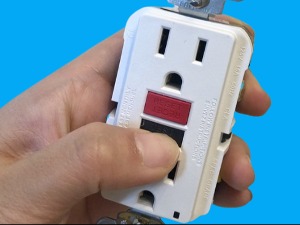
Ground fault circuit interrupters protect against electric shock. If your own gfci outlet keeps tripping, read on to find out why.
A ground fault circuit interrupter (GFCI) trips when it detects a ground fault , or current leakage even as little as 5mA between the hot and ground wire .
When the gfci detects the leakage current, it trips to protect you and the appliances plugged into the outlet.
The National Electrical Code recommends GFCI installation in every home, mostly in the bathroom and kitchen, to prevent electrocution and damage to appliances.
Related post : How to Install a GFCI Outlet in your Bathroom and Kitchen
Table of Contents
What causes a GFCI outlet to keep tripping?
A gfci device trips for so many reasons such as:
Ground faults
Ground faults occur when currents take an unintended path to the ground. Or when a hot wire touches the earth . When the ground fault occurs, currents leak to the ground.
The function of the GFCI receptacle is to detect when currents flow through an unintended path, which may be water or human.
Once the receptacle detects the current leakage, even as little as 0.005 amps, it shuts down.
This ground fault protection from the GFCI device helps protect us from electrical shock.
Related post: Circuit breaker keeps tripping without load . Causes and how to resolve them.
Causes of ground fault
- Faulty wiring
- Water touching the outlets or any naked cable.
- Worn out insulation.
Consult a qualified electrician to find the cause of the breaker trip.
Overload Circuit
Circuit overload occurs when you plug more appliances into a circuit than it can carry. Normally, a GFCL outlet handles between 15 and 20 amps. When you plug-in devices that draw more current than required, it trips the gfci.
Many things can cause circuit overload, including defective appliances, rusted wires, permanently installed electric motors, and others.
To see if the load is causing the tripping issues, do:
- Unplug the appliances plugged into the electrical outlet.
- Reset the gfci by pressing the reset button and wait for a few minutes to see if it will go off again. If it does, other faults may be responsible, but if it doesn’t trip, suspect the load.
- Plug back the appliances and watch if it goes off again. If it is the load that is causing the tripping, reduce it.
Wet receptacles
Since water is an excellent conductor of electricity, it can cause your outlet to trip. A wet receptacle can allow currents to flow through it to the ground, leading to loss of current.
This loss can vary the amount of currents going in and out of the circuit. Thus causing your GFCI to trip.
Electrical fault
If your GFCI breaker continues to go off, there may be an electrical issue arising from wrong connection.
Faulty connections can cause a current to leak to the ground, leading to a ground fault.
Faulty GFCI outlet
If, after trying the above methods, the GFCI still trips, replace the receptacle box with a new gfci.
You can buy a new outlet here@ Amazon
Call a licensed electrician to replace the outlet to avoid faulty connections.
You can also contact us at mariaelectrical.com to troubleshoot and replace the outlets for you.
How to troubleshoot and fix a tripping ground fault circuit interrupter (gfci)
Here are some steps you can take to fix a tripping GFCI:
Check the appliances
Unplug all the appliances connected to the GFCI and check if any part or wire is bad. A damaged wire or device can short circuit , causing the outlet to trip. If there is fault, change or replace the wire.
Check for overload
A GFCI can only handle a certain amount of electrical load . If you have too many appliances or devices connected to the outlet, it may trip. Try unplugging some devices and see if that fixes the problem.
Look for loose connection or bad wiring
Remove the plate cover from your outlet and inspect the wire connection. Make sure that the wiring is OK. And there is no loose connection or burnt wire.
If you are not familiar with wiring, call an electrician to inspect the wiring.
Check for moisture
GFCIs outlets trip when they detect moisture or water, make sure the environment is dry. If it is wet, clean it with dryer so that it will not conduct electricity.
Test and reset the gfci outlet
Press the “Test” button on the outlet to trip it. Then press the “Reset” button to restore power. If it trips again, the GFCI may need to be replaced.
Call a qualified electrician for assistance.
Mariaelectricals offers a range of electrical services and inspections. We have professionally trained and licensed electricians for your electrical work.
If your gfci outlet is constantly tripping, contact us to schedule an appointment .
Related articles
- What are the Differences Between Circuit Breakers and GFCIs?
- GFCI Won’t reset, 7 Causes and How to Fix it.
- Ungrounded Outlets Explained! Dangers and How to Fix the Issue.
About mariaelectricals
Hi, I am Emmanuel Nwankwo, a commercial electrician and the founder of mariaelectricals.com . I established this blog to share my decades of work experience in electrical installations and repairs.

Another Issue with the 2020 Electrical Code: Ranges Tripping on GFCIs
The Association of Home Appliance Manufacturers (AHAM) has released new recommendations for home builders and electrical contractors aimed at reducing nuisance tripping due to the use of ground fault circuit interrupters (GFCIs) for electric ranges in new construction and major remodeling projects per the current electrical code.
AHAM issued the recommendations in response to a 2020 National Electrical Code (NEC) requirement that 240-volt outlets located within six feet of a sink must be connected to a GFCI device in new construction and significant remodels. These NEC changes were not submitted for consideration to the safety standard for electric ranges, UL 858. As a result of this misalignment, nuisance tripping with electric ranges has become more common.
The move by a major trade association to address the GFCI requirement in the 2020 NEC is the latest red flag sent up by the housing industry that portions of the code were not written with real-world feasibility in mind. Last month, Texas had to take emergency action on the 2020 NEC over tripping concerns with HVAC systems.
AHAM, in a recent white paper , recommends that builders take proactive steps to reduce the frequency of nuisance tripping of electric ranges that may be placed within six feet of a sink:
- Relocate the outlet greater than six feet from a kitchen sink.
- Consider asking the appropriate local authorities to invoke section 90.4 of the NEC, which allows the code to roll back to the 2017 edition, eliminating the need for a GFCI breaker.
AHAM and electric range manufacturers have formally submitted a technical update to UL 858 that aims to improve compatibility with GFCI devices in household ranges going forward.
NAHB recommends home builders work their local HBAs to contact local code bodies and encourage them to either roll back the relevant sections of the 2020 NEC or to reconsider adopting the 2020 code. Many states are in the adoption process currently, and changes can still be made to avoid the tripping issues GFCIs are causing with common home appliances.
For questions about the electrical code, please contact Dan Buuck .
Subscribe to NAHBNow
Log in or create account to subscribe to notifications of new posts.
Latest from NAHBNow
May 24, 2024, may 23, 2024, latest economic news, may 22, 2024.
The NAHB website uses cookies. We do this to provide a personalized experience, improve our content, and monitor the site performance. By clicking Accept you consent to NAHB’s use of cookies in accordance with its Privacy Policy . To learn more and control what cookies are used, go to Manage Cookies .
Labor Day Sales Event Going on Now Through Sept. 11, 2023 Learn More
Double the savings hot tub rebate & financing event now through april 22 learn more, please enter a valid zip code.
- English (EN)
- Français (FR)
- Español (ES)
How to Fix a Tripped Hot Tub GFCI Circuit Breaker
Finally, you're the owner of the hot tub you've always wanted. Ever since you first brought it home, it's provided you with nothing but peace, relaxation, and comfort. Except for one small thing: The GFCI circuit breaker keeps tripping, shutting off the power to your spa just when you're settling in for a soak.
GFCI issues are a relatively common occurrence with hot tubs, and often can be resolved with little fuss or expense. However, because electricity and water are an extremely dangerous combination, make sure you know what you're doing before troubleshooting any electrical problems. Unless you're confident in your ability to address GFCI issues yourself, always consult a professional hot tub repair expert or electrician. An improperly-wired hot tub can result in electrocution or an electrical fire. Electrical work such as installing a hot tub or making adjustments to its components or wiring must be performed by a licensed electrician and must adhere to all local and national electrical codes. As a reminder, always turn off your hot tub and disconnect it from the power supply before attempting any repairs.
What is a GFCI circuit breaker?
A GFCI—a Ground Fault Circuit Interrupter—is a device used to protect your hot tub from unusual fluctuations or deviations in your power supply. Ground faults and short circuits occur when electricity takes a path the designers of the circuit didn't intend. When a GFCI detects an anomaly in the electrical supply, such as a ground fault or a short circuit, it interrupts the circuit and cuts off all electricity to your spa. When this interruption occurs, it's often referred to as “tripping” the GFCI.
WHERE IS MY GFCI?
Even if you've never experienced any electrical problems with your hot tub, make sure you know where your GFCI is located. While some hot tubs are designed to plug into a traditional 120-volt outlet, most will require the installation of both a GFCI circuit breaker and a dedicated electrical outlet designed to handle the increased voltage—generally 220 to 240 volts—necessary to power your spa. Most likely, you'll find your GFCI in the control panel located close to or containing the outlet your spa or hot tub uses. To reduce the risk of the electrical supply coming in contact with water, the National Electrical Code requires that the electrical components, including the GFCI, be located a minimum of six feet away from your hot tub.
HOW DO I RESET MY GFCI?
Your GFCI should have a visible reset button. These buttons are usually red and are clearly labeled “reset.” To reset your GFCI, simply press the button. This will restore the electricity supply to your spa.
WHY DOES MY GFCI KEEP TRIPPING WHEN I TURN ON MY HOT TUB?
When your GFCI trips, it's an indication that something unexpected has happened with your electrical supply. This might be a one-time occurrence, which may be resolved by simply pressing the button to reset the breaker. If your GFCI repeatedly trips whenever you turn on your hot tub, it means there's an ongoing problem that must be addressed and resolved. There are a few reasons why your GFCI might trip each time you power up your hot tub:
- There may be an issue with your GFCI. Disconnect all hot tub components from your GFCI, then reset it. If it immediately trips even though nothing is attached to it, your GFCI is most likely faulty and will need to be replaced.
- There may be an issue with one of your hot tub's components, such as the heater, the pumps, or the entertainment system. If these components can be individually disconnected from your GFCI, disconnect them all, then reconnect and test them one at a time. If any of them cause your GFCI to trip when you turn your hot tub on, the faulty component will most likely need to be serviced or replaced.
- Your GFCI may be wired incorrectly. To isolate a faulty switch or wire, disconnect wires one at a time to each switch, then test the GFCI to see if any individual wire causes it to trip.
Once again, it's important to stress that electricity can be harmful or fatal. If you aren't confident in your ability to safely troubleshoot electrical problems, call in a knowledgeable and experienced professional.
WHY DOES MY GFCI TRIP AT RANDOM TIMES?
Your GFCI may trip at seemingly random intervals, either while you're in the middle of a soak or when your hot tub is not in use. If your GFCI constantly trips, one of the following issues might be the culprit:
- Your hot tub heater may be corroded or otherwise damaged. Problems with the heating elements are among the most common causes of GFCI issues. Inspect your heater for visible signs of damage, and try operating your hot tub with the heater disconnected to see if the GFCI problem reoccurs.
- Your spa's electrical contacts have become corroded. Inspect each contact and replace any that show signs of corrosion.
- One or more electrical connections is loose. With the power to your spa disconnected, tug gently on each connection, then tighten and secure any that seem to be loose.
- The control box containing your GFCI has been exposed to moisture, such as rainwater or condensation. If the inside of your control box is damp, locate the source of the moisture, protect your box from future water exposure, and allow it to thoroughly dry out before testing the GFCI. If water has damaged any electrical components, replace them.
- There's a short in one or more of your electric components. Run your spa for 15 minutes, then turn it off, unplug your tub, and inspect your components by hand. Electrical components that are shorting out will feel warm to the touch. Replace any components which grew warm during your test.
WHERE CAN I FIND REPLACEMENT COMPONENTS OR GFCIS?
Your local hardware store will likely have replacement GFCIs and components for sale, or you can order them online. If you're not certain which model or configuration to purchase, talk to a repair professional or licensed electrician. The best way to find components for your hot tub is often by visiting the dealer who sold it to you . They will have advanced knowledge of your specific model and will either have parts in stock, or will be able to order them for you. They'll also have experience diagnosing and repairing similar problems and may be able to offer repair services or advice.
A GFCI circuit breaker that trips constantly is at best a nuisance, and could be an indication of a potentially hazardous situation with your hot tub. Armed with a little knowledge, you should be able to diagnose the problem with your GFCI and find a way to fix it, either by repairing it yourself or by calling upon the knowledge and services of your hot tub dealer or a licensed electrician. A tripped GFCI can be frustrating, but it doesn't have to get in the way of your enjoyment of your hot tub.
At Hot Spring ® Spas, we believe in providing the best possible ownership experience for our hot tub customers. That's why we strive to provide resources and support for our hot tub owners long after their spa has been delivered and installed. Whether they need help with a maintenance question or in locating a replacement part, our knowledgeable local dealers and informational website are there to help them every step of the way.
- Get Personal Quote
- Get Buyer’s Guide
- Find Dealer
- Get Brochure
Where are you located?
- svg]:stroke-accent-900"> 826K
- svg]:stroke-accent-900"> 622K
- svg]:stroke-accent-900"> 246K
- svg]:stroke-accent-900"> 45K
Why Is My Circuit Breaker Tripping? 4 Potential Problems and Solutions
By Glenda Taylor , Bob Vila , Evelyn Auer
Updated on Dec 21, 2023 8:55 PM EST
6 minute read
Photo: istockphoto.com
We may earn revenue from the products available on this page and participate in affiliate programs. Learn More ›
Q: Every few hours—sometimes minutes!—my living room and one side of my kitchen lose electrical power. I’ll check the breaker panel and, sure enough, a circuit breaker has tripped…again. Should I call an electrician, or is there a simple DIY fix I can try first?
A: While it’s frustrating when a circuit breaker keeps tripping, they are important safety mechanisms. Designed to shut off the electrical current when something goes wrong, circuit breakers are one of the best ways of protecting a home from an electrical fire. “When a circuit breaker trips, typically it is because we use too much electricity, which causes it to overload and turn off,” says Christopher Haas, expert electrician and owner of Haas & Sons Electric in Millersville, Maryland. For those who need an electrical panels 101 refresher course or aren’t sure how to reset circuit breakers, each breaker has an on/off switch and controls a separate electrical circuit in the home. When a breaker trips, its switch automatically flips “off,” and it must be manually turned back on to restore electricity to the circuit. For those wondering, “Is it dangerous if a circuit breaker keeps tripping?” the answer is that it can be, depending on the source of the problem. An electrician can ultimately deal with the root issue, but a little sleuthing will reveal whether it’s something that’s easily remedied.
In many cases, the cause of a circuit breaking tripping is an overloaded circuit.
A circuit overloads when more electrical current is being drawn through the wires than they can handle, tripping the circuit breaker. If this happens, there may be a few additional signs:
- Buzzing noises coming from outlets
- Devices charging slowly
- Electrical outlets not working
- Flickering lights
- Scorch marks on outlets and light switches
If a circuit breaker keeps tripping in one room, homeowners can test for circuit overload by turning off all the switches in the affected area and unplugging all appliances and devices. After the breaker is flipped back on, the devices can be turned back on one at a time, with homeowners waiting a few minutes in between to see if the circuit remains on. If the breaker trips before all the appliances are turned on, the experiment can be repeated, this time turning them on in a different order. It may be necessary to do this several times to find out how many appliances can be operated at once before the circuit overloads.
“As a short-term solution, you can unplug unnecessary appliances to prevent tripping circuit breakers. You may still get some trips, but you can limit them by unplugging devices that you don’t need to use,” advises Dan Mock, vice president of operations at Mister Sparky , an electrical company with 90 locations in the U.S. The best long-term solution, however, is to pay an electrician for the cost to rewire the house and add additional circuits. The cost to replace an electrical panel is about $1,274 on average.
Other times, the issue may be caused by a short circuit.
A “short” circuit means that two wires that should not be coming into contact are inadvertently touching, triggering a sudden surge of electricity through the wires. A short can occur in an outlet, a switch, or within an appliance if wires are loose or have been chewed through by mice or pets. Some signs of a short circuit include:
- Popping sounds
- Discolored outlets or switches
- Burning smells
Testing to see if an appliance has a short is similar to testing for an overloaded circuit. When an appliance that has a short in its wiring is turned on, it will immediately trip the circuit. Homeowners can also try plugging it into an outlet in a different room. If the breaker for that room trips, there’s a short in the appliance (if it’s unclear what breaker goes to what room, the breaker can be identified with one of the best circuit breaker finders ). Electrical shorts can be a major fire hazard, so it’s a good idea to call a licensed electrician for this circuit breaker repair. It’s wise to stop using the outlet or appliance until a pro takes care of the problem.
Another potential cause of a circuit breaker tripping is a ground fault.
A ground fault occurs when the electricity running through a home’s wiring diverts from the wiring loop and travels to the ground, usually due to faulty wiring or water infiltration in an outlet or switch box. Water is a conductor, which is why walking through puddles is often listed as something not to do in a power outage in case of downed power lines. Once water makes contact with wires, electricity can jump from the wiring loop and follow the water trail. This creates a surge in electricity leading to a tripped circuit breaker. If a person comes in contact with the electricity that is on its way to the ground, this can result in electrocution. Homeowners may notice a few signs of a ground fault, including:
- Tripped GFCI (ground fault circuit interrupter) outlets;
- A burning smell coming from an outlet; and
- Lights flickering.
Newer electrical breakers have features designed to protect against the danger of ground faults. According to Haas, “Ground fault breakers sense electricity going to earth as opposed to going through the wires of the circuit. You’ll find [these] for bathrooms, kitchens, garages, exteriors, and basements.” GFCI outlets are another safety feature that shut off the electric current within a fraction of a second of sensing a ground fault.
If a ground fault is the problem, the cause of the errant water must be discovered and repaired, and any damaged wiring must also be replaced. It’s also a good idea to install GFCI outlets in rooms where water is commonly used. A GFCI outlet costs $210 on average.
Sometimes a bad or worn-out circuit breaker can be the culprit.
In some cases, the circuit breaker itself may be faulty. Breakers that are old, damaged, or were installed incorrectly may trip frequently for no apparent reason. Alternatively, faulty breakers may not trip when they are supposed to, leaving the home at risk of electrical fire. Some signs of a bad circuit breaker include:
- The circuit breaker getting hot and tripping frequently;
- The circuit breaker won’t reset;
- It has been over 10 years since the breaker was last serviced; and
- The breaker has scorch marks.
An important electrical safety tip to keep in mind is that resetting a breaker over and over again can cause what is called an arc flash, which is a small electrical explosion that can be deadly. If resetting the breaker once does not remedy the issue, it’s a good idea for the homeowner to hire an electrician near them who knows how to replace a circuit breaker safely. Mock warns, “Don’t take any chances with circuit breakers. Instead, call a licensed electrician who knows the safe ways to replace breaker boxes, upgrade circuits, and diagnose potential electrical problems in your home.” Wiring a breaker box is a job to leave to an experienced electrician.
A professional electrician can help determine the specific cause of a frequently tripping circuit breaker.
Most circuit breaker problems—aside from those explained in the sections above—will need to be inspected and addressed by a licensed electrician. According to the Electrical Safety Foundation International (ESFI) , each year “thousands of people in the United States are critically injured and electrocuted as a result of electrical fires, accidents, [or] electrocution in their own homes.” While homeowners may be tempted to save on electrician costs by attempting circuit breaker replacement or repair themselves, electrical work is not suitable for casual DIYers. “Yes, you have to pay, but you can save many hours of head-scratching by hiring an electrician. Electricians will also have all the right tools for diagnosing and repairing the circuit,” Haas adds. “Lastly, they will come with a warranty/guarantee should something arise, and they will typically return at no additional cost.”
Anker’s New Home Battery Tower Is a Sleek, Modular Step Toward Complete Energy Independence Anker’s New Home Battery Tower Is a Sleek, Modular Step Toward Complete Energy Independence
By Chase Brush
The Government Is Paying People to Upgrade Their Home Comfort, Here’s Why The Government Is Paying People to Upgrade Their Home Comfort, Here’s Why
By Tony Carrick

IMAGES
VIDEO
COMMENTS
If insulation is old or damaged, its resistance is lower and leakage current could become substantial. GFCI Trips: On GFCI-protected circuits, leakage current can cause unnecessary and intermittent tripping. When many pieces of equipment are operating on a circuit, the leakage current is cumulative and could cause a GFCI to trip randomly.
Updated on February 17, 2024. There are several different reasons why a GFCI keeps tripping. The most common reason is water or moisture that has gotten into the receptacle box or outlet. However, a tripping GFCI device could also get caused by an overloaded circuit, a malfunctioning outlet, electrical issues, or improper installation.
But here in the last several weeks, three of the AFCI/GFCI breakers in the panel have started tripping intermittently, usually with no load on them. One AFCI/GFCI serves a single dedicated 20A laundry room outlet, another is to the master bathroom, and the third one serves 2 - 20A outlets in the kitchen. Interestingly, these three breakers are ...
Final Thoughts: If your GFCI outlet is tripping intermittently, start by observing the tripping pattern and assessing the circuit load. Check for any visible issues like water or worn wires. If the problem persists, strategically test each appliance on the circuit, such as by moving them to different GFCI circuits to isolate the issue.
Resetting the GFCI. When the GFCI trips, the first step is to reset it. Locate the GFCI outlet or breaker and press the reset button. If it clicks and stays in place, the issue may have been a temporary fault. However, if it immediately trips again, proceed with the following steps:
It can be caused by various factors, such as damaged wiring, faulty appliances, or moisture infiltration. To identify the source of the problem, a thorough inspection of the wiring, outlets, and connected devices is essential. Look for any signs of damage, loose connections, or moisture accumulation, as these can contribute to recurring trips.
Any slight damage means the electrical part is no longer protected from contact. 2. Moisture in the Receptacle Box. The accumulation of moisture is another major cause of GFCI tripping. Outdoor GFCI outlets are the most vulnerable, and rain is the most common culprit. However, due to the tropical climate of Florida, high humidity can also cause ...
Overloaded Circuit. Short Circuit. How to Fix a GFCI Outlet That Keeps Tripping. Step 1: Identify the Problem. Step 2: Turn Off the Power. Step 3: Test the Outlets and Appliances. Step 4: Replace the GFCI Outlet. Conclusion.
The following best practices can help confirm proper operation and reduce nuisance tripping. Minimize the number of appliances protected by each GFCI. Minimize the circuit length from the GFCI circuit breaker to the receptacle - a maximum conductor length of 150' is good rule of thumb.
If your GFCI outlet has tripped, here's how to reset it: Unplug all devices from the outlet. Press the "reset" button: This will restore power to the outlet. Plug in your devices one at a time: If the outlet trips again, it may be overloaded, or there may be a fault in the device you're plugging in. If the outlet keeps tripping, it may be ...
Unplug all devices from the GFCI outlet: If the GFCI outlet stops tripping when you unplug everything from it, the problem may be an overload of the circuit. Dry out the outlet: If the GFCI outlet is located in a moist area, such as a bathroom or kitchen, make sure it is dry. You can use a hairdryer or fan to dry out the outlet.
Press the GFCI reset button on the center of the receptacle. One by one, plug in and turn on each device. When the GFCI trips, there are two possibilities: either the last appliance you plugged in is leaking electricity and causing a ground fault, or the number of devices is overloading the circuit. Unplug all of the devices and reset the outlet.
A bad breaker can cause a GFCI outlet to trip repeatedly. A breaker is responsible for interrupting the flow of electricity when there's an overload or short circuit. If the breaker is faulty, it may trip even when there's no overload or short circuit. This can cause the GFCI outlet to trip repeatedly, leaving you without power in the affected ...
I have a 20amp AFCI circuit breaker supplying the bathroom's GFCI receptacle, all with 12 gauge wires. This receptacle then supplies power to the light and fan via a double gang box. Intermittently and randomly, the GFCI trips itself, but only when either the fan or light switches are toggled.
Why do GFCI Ground Fault Circuit Interrupter Trip? Nuisance trips of GFCIs can make you tempted to remove the GFCI but they serve an important safety purpo...
EC. Mar 3, 2021. #19. kwired said: Nearly every time I get called for engine heaters tripping GFCI's the engine heater, the supply cord or even any extension cord being used ends up having ground fault conditions. Can be intermittent depending on amount of moisture presence at times.
Check for moisture. GFCIs outlets trip when they detect moisture or water, make sure the environment is dry. If it is wet, clean it with dryer so that it will not conduct electricity. Test and reset the gfci outlet. Press the "Test" button on the outlet to trip it. Then press the "Reset" button to restore power.
There are two GFCI outlets in the line which never have tripped during an outage. Also, the breakers at the panel do not trip. I tested one of the GFCI outlets with the panel breaker off, for that circuit, and found 1 volt coming through. Also I turned the panel breaker on then tripped the GFCI and found it still registered 120 volts.
AHAM issued the recommendations in response to a 2020 National Electrical Code (NEC) requirement that 240-volt outlets located within six feet of a sink must be connected to a GFCI device in new construction and significant remodels. These NEC changes were not submitted for consideration to the safety standard for electric ranges, UL 858. As a ...
Find out the cost to replace an electrical panel. On every breaker, there will be an "On" and "Off" position. On a tripped breaker, the handle will be in the middle, neither On nor Off. To reset, flip the handle to Off first, then to On. Stand to the side of the panel and turn your face away when flipping breakers.
A new service pole with a 30 circuit main breaker panel below the meter base. On each side of the panel a 20 amp GFCI receptacle is mounted in a weatherproof box with a weatherproof in use cover. Each receptacle is supplied by a 20 amp single pole breaker. The problem: Both receptacles are randomly tripping with nothing connected to them.
A GFCI circuit breaker that trips constantly is at best a nuisance, and could be an indication of a potentially hazardous situation with your hot tub. Armed with a little knowledge, you should be able to diagnose the problem with your GFCI and find a way to fix it, either by repairing it yourself or by calling upon the knowledge and services of ...
Devices charging slowly. Electrical outlets not working. Flickering lights. Scorch marks on outlets and light switches. If a circuit breaker keeps tripping in one room, homeowners can test for ...